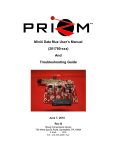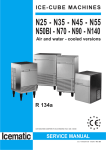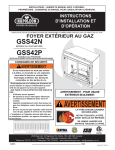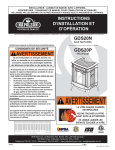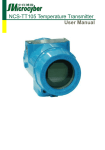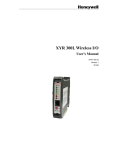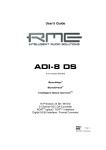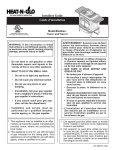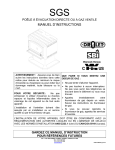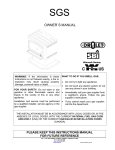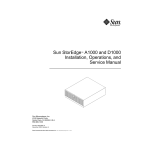Download SERVICE MANUAL - McCulloch Spares, Parts & Accessories
Transcript
SERVICE MANUAL COOKING Built-in hobs © ELECTROLUX ZANUSSI S.p.A. Corso Lino Zanussi,30 I - 33080 PORCIA /PN (ITALY) Tel +39 0434 394850 Fax +39 0434 394096 Publication number 599 36 62-62 GAS HOBS WITH ELECTRONIC IGNITION EN/SERVICE/FV SOI Edition: 04.2005 SOI 04.05 FV 1/57 599 36 62-62 SOI 04.05 FV 2/57 599 36 62-62 TABLE OF CONTENTS 1. INTRODUCTION ......................................................................................................................................... 6 PURPOSE OF THIS MANUAL ................................................................................................................ 6 ESD - Electrostatic Discharge and its effect on the components ............................................................ 6 GENERAL DESCRIPTION ...................................................................................................................... 6 2. TECHNICAL CHARACTERISTICS ............................................................................................................. 7 2.1 GENERAL TECHNICAL DATA ................................................................................................................ 7 2.2 CHARACTERISTICS OF BURNERS AND NOZZLES ............................................................................ 7 3. CONTROL SECTION AND BURNERS ....................................................................................................... 8 3.1 POSITIONS OF THE CONTROLS .......................................................................................................... 8 3.2 MAIN ON/OFF KEY ................................................................................................................................. 9 3.3 BURNER CONTROL PANEL................................................................................................................. 10 3.4 TIMER CONTROL PANEL..................................................................................................................... 11 3.5 CHILD SAFETY FEATURE.................................................................................................................... 12 4. ELECTRONIC GAS CONTROL SYSTEM ................................................................................................ 13 4.1 OVERVIEW OF THE SYSTEM.............................................................................................................. 13 4.2 OPERATION OF THE SYSTEM ............................................................................................................ 14 4.3 BASIC CIRCUIT DIAGRAMS................................................................................................................. 15 BASIC CIRCUIT DIAGRAM: GAS SUPPLY AND CONTROL SYSTEMS.................................................... 15 IGNITION CIRCUIT - BASIC DIAGRAM ....................................................................................................... 16 4.4 SYSTEM COMPONENTS...................................................................................................................... 17 4.4.1 POWER BOARD .................................................................................................................................. 17 4.4.2 SENSOR CONTROL INTERFACE CIRCUIT BOARDS ...................................................................... 18 4.4.3 POWERED FLAME MODULATION VALVES...................................................................................... 20 Fig. 15............................................................................................................................................................ 21 4.4.4 MAIN SAFETY SOLENOID VALVE ..................................................................................................... 22 4.5 POSITIONS OF THE COMPONENTS INSIDE THE HOB .................................................................... 23 5. OPERATING THE HOB (extract from Instruction Booklet) ....................................................................... 24 5.1 TOUCH CONTROL KEYS ..................................................................................................................... 24 5.2 LIGHTING THE BURNER...................................................................................................................... 24 5.3 SWITCHING OFF THE BURNERS........................................................................................................ 26 5.4 FAILURE TO LIGHT .............................................................................................................................. 26 5.5 IF THE FLAME GOES OUT (AUTOMATIC RE-IGNITION)................................................................... 26 5.6 SWITCHING OFF ALL THE BURNERS ................................................................................................ 27 5.7 AUTOMATIC BURNER SWITCH-OFF .................................................................................................. 27 5.8 AUTOMATIC HOB SWITCH-OFF.......................................................................................................... 27 5.9 PROTECTING AGAINST OVERHEATING ........................................................................................... 28 5.10 CHILD SAFETY FEATURE ................................................................................................................ 28 5.11 TIMER................................................................................................................................................. 29 5.10.1 PROGRAMMING THE BURNER SWITCH-OFF TIME...................................................................... 29 5.10.2 USING THE TIMER WITH THE BURNERS SWITCHED OFF/MINUTE-MINDER FUNCTION........ 31 6. ADAPTING THE HOB TO DIFFERENT TYPES OF GAS......................................................................... 32 6.1 REPLACING THE NOZZLES................................................................................................................. 32 6.2 ADJUSTING THE HOB FOR THE TYPE OF GAS................................................................................ 32 6.3 ADJUSTING THE MINIMUM SETTING................................................................................................. 33 7. ERROR CODES ........................................................................................................................................ 34 8. TROUBLE-SHOOTING ............................................................................................................................. 37 8.1 TROUBLE-SHOOTING USING ERROR CODES ................................................................................. 37 8.1.1 ERRORS WITH BURNER BLOCK ...................................................................................................... 37 8.1.2 TROUBLE-SHOOTING WITHOUT ERROR CODES .......................................................................... 38 8.1.2 TROUBLE-SHOOTING WITHOUT ERROR CODES .......................................................................... 39 8.1.2 TROUBLE-SHOOTING WITHOUT ERROR CODES .......................................................................... 40 8.2 TROUBLESHOOTING WITHOUT ERROR CODE................................................................................ 42 9. ACCESSIBILITY ........................................................................................................................................ 43 9.1 REMOVAL OF TOP FROM THE CABINET........................................................................................... 43 9.2 REMOVAL OF GAS SUPPLY CONNECTION ...................................................................................... 43 9.3 REMOVAL OF UPPER TOP.................................................................................................................. 44 9.4 ACCESS TO COMPONENT ZONE ....................................................................................................... 46 16 - MAIN SAFETY VALVE.................................................................................................................................. 46 9.4.1 DISMOUNTING THE BURNER CONTROL ELECTRICA VALVES .................................................... 47 9.4.2 DISMOUNTING THE MAIN SAFETY ELECTRIC VALVE................................................................... 48 9.4.3 REPLACEMENT OF INTERFACE BOARDS....................................................................................... 49 1.1 1.2 1.3 SOI 04.05 FV 3/57 599 36 62-62 9.4.4 REPLACEMENT OF POWER BOARD................................................................................................ 50 9.4.5 – REPLACEMENT OF BURNERS....................................................................................................... 51 9.4.6 REPLACEMENT OF THERMOCOUPLES .......................................................................................... 52 9.4.7 REPLACEMENT OF IGNITION SPARK PLUGS................................................................................. 54 10. ELECTRIC DIAGRAMS............................................................................................................................. 55 10.1 BASIC ELECTRIC DIAGRAM ............................................................................................................ 55 10.2 WIRING DIAGRAM ............................................................................................................................ 56 10.3 KEY TO DIAGRAM............................................................................................................................. 57 SOI 04.05 FV 4/57 599 36 62-62 GENERAL PRECAUTIONS - These appliances are designed to operate using natural gas (methane) and LPG. The appliances are factory-set for use with natural gas (methane). If a different type of gas is utilized (such as LPG), the hob can be re-calibrated by replacing the gas nozzles. - It is essential to ensure that there is adequate air circulation around all gas appliances. Inadequate ventilation, as well as causing the appliance to malfunction, may also result in a lack of oxygen that might be hazardous for persons. - Installation and connection to the gas and electricity circuits must be carried out by qualified personnel in compliance with all current safety legislation. - After being in use for a short time, and for some time after switching off, the cooking areas and the surrounding surface will remain very hot. A pilot lamp located on the hob remains lit until these cool down. In order to avoid serious burns, it is important to ensure that no person touches the surface while the pilot lamp is lit. - Do not switch on the burners without pans in the cooking areas, otherwise the hob may overheat and, after a time, the burner will switch off. SOI 04.05 FV 5/57 599 36 62-62 1. INTRODUCTION 1.1 PURPOSE OF THIS MANUAL The purpose of this Manual is to provide technical details regarding the new control system for built-in gas hobs so that trouble-shooting and repairs cab be carried out correctly. 1.2 ESD - Electrostatic Discharge and its effect on the components The interface for the control unit is not fitted with an internal device to protect against electrostatic discharge (multiple connectors). When effecting repairs, therefore, the service engineer must check for stabilization of the potential on the oven casing (i.e. discharge any static electricity by touching the oven casing) in order to prevent the possibility of overload, which might damage the control unit. The same care is necessary when handling control units supplied as spare parts (i.e. not yet fitted to the oven), which must be removed from the protective bag in ESD only after stabilizing the potential (i.e. discharging any static electricity) and only then installed in the appliance. Important: The theory behind the process of electrostatic charge and discharge is not discussed in this Manual, since the tangible effects are considered to be more important. However, the effects are felt frequently when touching a metal handle and feeling the electrostatic discharge in the form of a minor shock. But what happens when stabilization of the potential takes place with semi-conductor components (i.e. components on a circuit board, such as integrated circuits, microprocessors etc.)? Stabilization of the potential takes place across the internal structure of the component. This does not necessarily lead to the immediate destruction of the component; subsequent malfunctions across damaged internal connections may be more harmful, and these occur only as a result of overheating or current overloads. It is true that almost all sensitive semi-conductor components (such as MOS circuits) have been improved by the addition of protective measures, but the internal structures of these components are today smaller than, for example, ten years ago, which tends to increase their sensitivity to the previous levels. Important! Which components are susceptible to damage by static electricity during repairs? All circuit boards featuring control and command accesses (door switches, food probes etc.), bare tracks and microprocessors, as well as any other circuits with free access. Examples: - Programmers with access to the food probe and the door switch. Programmers whose control processors are accessible (due to their high costs, the protective systems are only partial). W.O.E.C. control units. S.O.E.C. control units. C.H.E.C. control units. KRONOS control units. Interface board of the Electronic gas hob. 1.3 GENERAL DESCRIPTION In these hobs, the burners are controlled entirely by a special electronic system that actions special solenoid valves which regulate the quantity of gas delivered to the burners. With the introduction of this electronic control system, it is now possible to fit Touch Control keys, as well as to provide greater safety, such as automatic re-lighting of the burners, and several control functions, including indication of residual heat, child safety feature, interruption of all operations using a single switch, safety cut-off in case of power failure or failure to light, automatic timer-controlled switching off and programmed operation of the burners. These functions are described in this manual. SOI 04.05 FV 6/57 599 36 62-62 2. TECHNICAL CHARACTERISTICS 2.1 GENERAL TECHNICAL DATA VOLTAGE POWER ABSORPTION DIMENSIONS OF CABINET (HxWxD) V W cm 220 - 230 20 3x71x47 AUTOMATIC IGNITION: AUTOMATIC RE-IGNITION GAS CONTROL SYSTEM TYPE SAFETY SOLENOID VALVE MODULATION SOLENOID VALVE RAPID BURNERS: SEMI-RAPID BURNERS: AUXILIARY BURNERS: TEMPERATURE LIMITS N° N° N°/kW N°/kW N°/kW °C AUTOMATIC BURNER SWITCH-OFF PROGRAMMING OF BURNERS MAX. TIME. SI SI ELECTRONIC WITH TOUCH CONTROL 1 4 (1 x BURNER) 1 / 2,9 (G20) – 2,7 (G30) 2 / 1,9 1 / 1,0 95°C Burner at minimum 105°C Hob is cut off After 4 hours 40 minutes 2.2 CHARACTERISTICS OF BURNERS AND NOZZLES Type of GAS Type of burner (R - L) Nozzle marking (mm/100) Nominal thermal delivery kW Nominal delivery in m3/h g/h Nominal pressure (mbar) Natural gas (methane) (G20) Rapid : Semi-rapid : Auxiliary : 119 96 70 2,6 1,6 1,6 0,286 0,181 0,095 - 20 Natural gas (methane) (G25) Rapid : Semi-rapid : Auxiliary : 124 100 71 2,6 1,6 1,6 0,286 0,181 0,095 - 25 LPG/Propane or (G30) (G31) Rapid : Semi-rapid : Auxiliary : 86 71 50 2,5 1,6 1,6 - 195 137 72 28-30 (G30) 37 (G31) (*) Certain models only NOTE : The consumption and delivery figures are approximate; the exact values are shown in the instruction booklets for each model. SOI 04.05 FV 7/57 599 36 62-62 3. CONTROL SECTION AND BURNERS 3.1 POSITIONS OF THE CONTROLS The figure below illustrates the positions of the controls and the burners. Fig. 1 BR-R (*) BR-S/R 1 BR-S/R 2 BR-A BR-R CONTROL BR-S/R 1 CONTROL BR-S/R 2 CONTROL BR-A MAIN ON /OFF TIMER BOARD SAFETY BLOCK (*) SOI 04.05 FV - RAPID BURNER (FRONT-RIGHT) SEMI-RAPID BURNER (REAR-LEFT) SEMI-RAPID BURNER (REAR-RIGHT) AUXILIARY BURNER (FRONT-LEFT) TOUCH CONTROL FOR RAPID BURNER (FRONT-RIGHT) TOUCH CONTROL FOR SEMI-RAPID BURNER (REAR-LEFT) TOUCH CONTROL FOR SEMI-RAPID BURNER (REAR-RIGHT) TOUCH CONTROL FOR AUXILIARY BURNER (FRONT-LEFT) TOUCH CONTROL - MAIN ON/OFF TOUCH CONTROL - TIMER TOUCH CONTROL - CHILD SAFETY FEATURE Certain models are fitted with a triple-crown burner in place of the rapid burner (see table of burners and nozzles) 8/57 599 36 62-62 3.2 MAIN ON/OFF KEY The hob is fitted with a main ON/OFF key. The appliance must be switched on before the burners can be ignited. When the appliance is switched on, the corresponding LED lights. The ON/OFF switch can be used to switch off all the burners at the same time, which may be necessary if liquids boil over or in situations in which children may be in danger. Fig. 2 ON / OFF LED MAIN ON / OFF SOI 04.05 FV - LED INDICATING THAT THE APPLIANCE IS SWITCHED ON MAIN ON / OFF SWITCH 9/57 599 36 62-62 3.3 BURNER CONTROL PANEL Each burner is operated from a specific area of the control panel as indicated in the figure below. Each of the control areas indicates the position of the corresponding burner, the touch control for switching the burner on and off, a LED indicating residual heat, six LEDs indicating the burner setting (level 0 is the lowest setting) and two touch controls for increasing and decreasing the flame. Fig. 3 ON / OFF BURNER BURNER ZONE RESIDUAL HEAT LED FLAME LEVEL LEDS INCREASING FLAME DECREASING FLAME SOI 04.05 FV - SWITCHES THE BURNER ON AND OFF INDICATES THE POSITION OF THE BURNER LED INDICATING RESIDUAL HEAT 6 LEDs INDICATING THE LEVEL OF THE FLAME TOUCH CONTROL - INCREASES THE FLAME TOUCH CONTROL - DECREASES THE FLAME 10/57 599 36 62-62 3.4 TIMER CONTROL PANEL This type of hob also features programmable operation for each burner. The various settings are controlled from the specific zone shown below. The programming function (which switches off the burner at the end of a preset time) can be used for one burner only at a time. The maximum programming time is 40 minutes. Fig. 4 COOKING TIME DISPLAY BURNER ZONE LED ON / OFF PROGRAMME INCREASING TIME / BURNER DECREASING TIME / BURNER SOI 04.05 FV - DISPLAYS THE TIME FOR WHICH THE BURNER WILL REMAIN LIT LED INDICATING THE CORRESPONDING BURNER TOUCH CONTROL - SWITCHES THE PROGRAMME ON AND OFF TOUCH CONTROL - INCREASES TIME OR SELECTS BURNER TOUCH CONTROL - DECREASES TIME OR SELECTS BURNER 11/57 599 36 62-62 3.5 CHILD SAFETY FEATURE The hob features a child safety system in which the user can disable the controls to prevent inadvertent actioning by children. When the child safety feature has been selected, only the main ON/OFF switch is enabled (see Fig. 2, page 9). Fig. 5 SAFETY BLOCK LED SAFETY BLOCK ON / OFF SOI 04.05 FV - LED: CHILD SAFETY FEATURE ON TOUCH CONTROL: SWITCHES ON CHILD SAFETY FEATURE 12/57 599 36 62-62 4. ELECTRONIC GAS CONTROL SYSTEM 4.1 OVERVIEW OF THE SYSTEM This electronic system is designed to be fitted to Electrolux "Gas on Glass" built-in hobs (70x60 cm) with uncovered burners. Its main characteristics are as follows: SOI 04.05 FV - Control of four current-production Electrolux burners (uncovered): one rapid, two semi-rapid, one auxiliary. - Hob in special high-strength safety glass (thickness up to 8 mm). - Ignition system with 230V spark generator and spark plug. - Flame detection with thermocouple. - Wiring circuit comprising the following: - Connection between circuit board and valves. - Connection between circuit board and spark generator. - Connection between circuit board and power circuit. - Connection between circuit board and thermocouples. - Connection between interface circuit boards and power board. - Electronic control system comprising: - Power board. - Interface board (left) - Interface board (right) - General interface board with: ON/OFF, child safety feature, timer module, display. - The following gas valves are featured: - A main safety valve (automatic) - A modulation valve for each burner (four in total) - User interface system with touch control: each interface controls two burners. Each interface board has the following characteristics: - "+" and "–" touch controls for adjustment of the flame. - Flame level indicator: 6 levels with LED indication (Levels 1 - 5: modulation; level 6: valve completely open). - LED indicators: one LED lights to indicate that the burner is in operation; a second LED warns the user about residual heat around each burner. The general interface has the following characteristics: - "ON" AND "OFF" controls. - Timer function with display module - Child safety function. - A single version of the power board which can be customized via software. - Easily-customized user interface software. 13/57 599 36 62-62 4.2 OPERATION OF THE SYSTEM When the user wishes to light one of the burners using the touch control on the burner control panel, the main safety valve VS (Fig. 6) opens (unless the valve is already open and feeding a different burner). The corresponding modulation valve VM opens and the spark generator actions the spark plug which ignites the burner. The burner is always ignited at maximum setting. At this point, the flame detection procedure takes place. If the burner has failed to ignite, the ignition system makes two more attempts. On each burner, the level of the flame can be adjusted using keys setting is displayed by the flame level LEDs. or while the flame In the event of problems with a burner (e.g. if the burner is wet etc.) and the main switch is set to ON, it is possible to disable only the valve (VM) relative to that burner, using the touch control . This interrupts the supply of gas only to the single burner, while the remaining burners continue to operate normally. If the power supply is switched off or if the electronic control system detects a malfunction (e.g. a problem with the electrical connections), the main valve VS and the corresponding modulation valve VM intervene to cut off the gas supply to the burners. In all cases, therefore, the gas supply to the burners is controlled by at last two safety valves. After a power failure, the system remains disabled, which is indicated by the flashing of all the LEDs in the hob control zone. To restore the burners to normal operation after a power failure (LEDs flashing), it is necessary to wait at least 60 seconds and then press buttons simultaneously and then button and , , after which the burner can be used normally. The presence of residual heat on and around the burners is indicated by the corresponding LEDs positioned on the hob control panels. If the temperature in the electronic section should exceed about 95°C, in order to prevent possible damage, the system reduces all the burners to the lowest setting; if the temperature should exceed 105°C, then all the safety valves that control the supply to the burners are closed and an error code is displayed. SOI 04.05 FV 14/57 599 36 62-62 4.3 BASIC CIRCUIT DIAGRAMS BASIC CIRCUIT DIAGRAM: GAS SUPPLY AND CONTROL SYSTEMS Fig. 6 IN GAS VS VM SP TC BR-R BR-S/R BR-A TIMER BOARD TOUCH DX BOARD TOUCH SX BOARD SOI 04.05 FV - GAS INLET MAIN SAFETY VALVE POWERED MODULATION VALVE SPARK PLUG THERMOCOUPLE RAPID BURNER SEMI-RAPID BURNER AUXILIARY BURNER MAIN TOUCH-CONTROL INTERFACE BOARD RH TOUCH-CONTROL INTERFACE BOARD LH TOUCH-CONTROL INTERFACE BOARD 15/57 599 36 62-62 IGNITION CIRCUIT - BASIC DIAGRAM Lighting of the burners is performed by the spark plugs, which are powered by a single spark generator actioned by the power board. Fig. 7 SP TC BR-R BR-S/R BR-A POWER BOARD TIMER BOARD TOUCH DX BOARD TOUCH SX BOARD SOI 04.05 FV - SPARK PLUG THERMOCOUPLE RAPID BURNER SEMI-RAPID BURNER AUXILIARY BURNER POWER BOARD MAIN TOUCH-CONTROL INTERFACE BOARD RH TOUCH-CONTROL INTERFACE BOARD LH TOUCH-CONTROL INTERFACE BOARD 16/57 599 36 62-62 4.4 SYSTEM COMPONENTS The system comprises four circuit boards: one power board and three interface boards. The hob controls are divided among the three general interface boards: - General interface and timer board. - RH interface board, connected directly to the general interface board. - LH interface board, identical to the RH board but connected directly to the power board. The gas is controlled by a main safety solenoid valve and by four powered modulation valves (one for each burner). The presence of a flame is detected by four thermocouples (one for each burner). 4.4.1 POWER BOARD The power board is customized by a software that defines all the system's control and safety parameters. This software is entered on completion of the production of the hob. The main functions of the power board are as follows: - Control for spark generator for lighting the burners. Flame presence detection by thermocouples Control of the main safety valve. Control of the modulation valve for each burner. Regulation, control and diagnostics for each burner. Fig. 8 Fig. 8 AUX1 TC1 TC2 TC3 TC4 BC1 BC2 BC3 BC4 BCX N PE LO L SOI 04.05 FV - SERIAL LINE CONNECTION TO INTERFACE BOARD CONNECTION TO INTERFACE BOARD CONNECTION TO INTERFACE BOARD CONNECTION TO INTERFACE BOARD POWER TO SOLENOID VALVE - BURNER BR-A POWER TO SOLENOID VALVE - BURNER BR-R POWER TO SOLENOID VALVE - BURNER BR-S/R 2 POWER TO SOLENOID VALVE - BURNER BR-S/R 1 POWER TO MAIN SAFETY SOLENOID VALVE POWER SUPPLY (NEUTRAL) EARTH POWER TO SPARK GENERATOR POWER SUPPLY (LIVE) 17/57 599 36 62-62 4.4.2 SENSOR CONTROL INTERFACE CIRCUIT BOARDS This hob is provided with a touch sensor control device. To insert the controls in the hob, some sensors interface electronic PCBs are used in place of the normal buttons which control the switches placed in the control unit. The system consists of sensor PCBs placed under the glass which recognise the presence of a finger at a distance of about 4 mm from the sensors (glass thickness). The sensor PCBs include different control units with touch sensors used on the basis of the control software (see Fig. 9, 10 and 11). Fig. 9 The functions of the various controls and of the LEDs and displays are listed below. BOARD FOR LEFT FRONT AND LEFT REAR SECTIONS Fig. 10 ON / OFF BR-S/R 1 BURNER ON/OFF - REAR LEFT BURNER BR-S/R 1 RESIDUAL HEAT LED RESIDUAL HEAT - REAR LEFT BURNER BR-S/R 1 FLAME LEVEL LEDS FLAME LEVEL LEDs - REAR LEFT BURNER BR-S/R 1 DECREASING FLAME DECREASE FLAME - REAR LEFT BURNER BR-S/R 1 INCREASING FLAME INCREASE FLAME - REAR LEFT BURNER ON / OFF BR-R BURNER ON/OFF - FRONT LEFT BURNER BR-R RESIDUAL HEAT LED RESIDUAL HEAT - FRONT LEFT BURNER BR-R FLAME LEVEL LEDS FLAME LEVEL LEDs - FRONT LEFT BURNER BR-R DECREASING FLAME DECREASE FLAME - FRONT LEFT BURNER BR-R INCREASING FLAME INCREASE FLAME - FRONT LEFT BURNER SOI 04.05 FV 18/57 599 36 62-62 MAIN BOARD / TIMER Fig. 11 BR-S/R 1 LED LED FOR REAR LEFT BURNER BR-S/R 2 LED LED FOR REAR RIGHT BURNER BR-A LED LED FOR FRONT LEFT BURNER BR-R LED LED FOR FRONT RIGHT BURNER ON / OFF BR-S/R 2 BURNER ON/OFF - REAR RIGHT BURNER BR-S/R 2 RESIDUAL HEAT LED RESIDUAL HEAT - REAR RIGHT BURNER BR-S/R 2 FLAME LEVEL LEDS FLAME LEVEL LEDs - REAR RIGHT BURNER BR-S/R 2 DECREASING FLAME DECREASE FLAME - REAR RIGHT BURNER BR-S/R 2 INCREASING FLAME INCREASE FLAME - REAR RIGHT BURNER ON / OFF BR-R BURNER ON/OFF - FRONT RIGHT BURNER BR-R RESIDUAL HEAT LED RESIDUAL HEAT - FRONT RIGHT BURNER BR-R FLAME LEVEL LEDS FLAME LEVEL LEDs - FRONT RIGHT BURNER BR-R DECREASING FLAME DECREASE FLAME - FRONT RIGHT BURNER BR-R INCREASING FLAME INCREASE FLAME - FRONT RIGHT BURNER BOARD FOR RIGHT FRONT AND RIGHT REAR SECTIONS SOI 04.05 FV 19/57 599 36 62-62 4.4.3 POWERED FLAME MODULATION VALVES The flame control valves comprise two sections: the modulation section and the safety valve section. Fig. 11 1 2 3 4 - 5 6 - ELECTRICAL CONNECTORS (FASTONS) CONNECTOR FOR MODULATION MOTOR VALVE SOLENOID MODULATION MOTOR (STEPPING LINEAR ACTUATOR) GAS INLET COUPLING GAS DELIVERY COUPLING The modulation section SM comprises a pressure regulator which, by means of a stepping linear actuator APP, compresses the regulation spring M1 , thus obtaining one of the six levels of closure of element O1. The output pressure varies according to the compression of the spring M1 and therefore according to the electronic control system. When actuator APP is in the minimum compression position of spring M1, the closing element O1 is forced into the closed position by spring M2. On the contrary, when the actuator is at maximum position (i.e. when the flame is at maximum setting), the closing element O1 is forced into the completely-open position. In this way the SM assembly acts as a modulator for the delivery pressure and therefore for the power of the burner (flame setting). The SM assembly also serves to cut off the gas. The safety solenoid section EV consists of a control coil EM and a closure element O2, and acts as a safety valve. Fig. 12 APP EM EV M1 M2 O1 O2 SM - LINEAR STEPPING ACTUATOR (MOTOR) CONTROL COIL SAFETY VALVE REGULATION SPRING CLOSURE SPRING MODULATOR CLOSING ELEMENT CLOSING ELEMENT FOR SAFETY VALVE MODULATOR SOI 04.05 FV 20/57 599 36 62-62 OUTPUT PRESSURE (mbar) PRESSURE DIAGRAM WITH 20mbar NATURAL GAS NO. OF STEPS Fig. 14 OUTPUT PRESSURE (mbar) PRESSURE DIAGRAM WITH 37mbar LIQUID GAS NO. OF STEPS Fig. 15 SOI 04.05 FV 21/57 599 36 62-62 MODULATION CONTROL MOTOR (STEP-BY-STEP) The modulation control motor of the solenoid valves is a unipolar step-by-step type. Please find below the connection diagram of the motor and the rotation diagram. MOTOR CONNECTION DIAGRAM MOTOR CONNECTOR BLK Black RED Red BRW Brown ORG Orange YEL Yellow BLK RED BRW ORG RED YEL ANTI-CLOCKWISE ROTATION CLOCKWISE ROTATION ROTATION DIAGRAM BLK BRW ORG YEL RED/ RED A BLK A COM RED _ A BRW UNIPOLAR MOTOR B ORG _ B YEL ROTATION DIAGRAM STARTING FROM THE PAUSE POSITION Fig. 17 4.4.4 MAIN SAFETY SOLENOID VALVE The function of the main safety valve is to provide an extra safety feature in controlling the delivery of gas. The internal structure and the operation of the valve are identical to the EM section of the burner control valves described in the corresponding section. Fig. 17 1 2 3 4 SOI 04.05 FV - ELECTRICAL CONNECTOR (FASTON) SOLENOID GAS DELIVERY COUPLING GAS INLET COUPLING 22/57 599 36 62-62 4.5 POSITIONS OF THE COMPONENTS INSIDE THE HOB The figure below shows the positions of the various components inside the hob. Fig. 18 1 2 3 4 5 6 7 8 9 10 11 12 13 14 15 SOI 04.05 FV - MAIN SAFETY SOLENOID VALVE LEFT REAR BURNER BR-S/R 1 (SEMI-RAPID) TERMINAL BLOCK FOR POWER SUPPLY SPARK GENERATOR RIGHT REAR BURNER BR-S/R 2 (SEMI-RAPID) GENERAL INTERFACE BOARD (TOUCH CONTROL) POWER BOARD RIGHT FRONT BURNER BR-R (RAPID) LEFT FRONT BURNER BR-A (AUXILIARY) CONTROL VALVE FOR LEFT FRONT BURNER BR-A (AUXILIARY) LEFT INTERFACE BOARD (TOUCH CONTROL) CONTROL VALVE FOR RIGHT FRONT BURNER BR-R (RAPID) CONTROL VALVE FOR RIGHT REAR BURNER BR-S/R 2 (SEMI-RAPID) CONTROL VALVE FOR LEFT REAR BURNER BR-S/R 1 (SEMI-RAPID) POWER BOARD 23/57 599 36 62-62 5. OPERATING THE HOB (extract from Instruction Booklet) Before using the appliance, remove all packaging material, including advertising labels and protective film, if any. 5.1 TOUCH CONTROL KEYS The hob is operated using special "touch control" sensor keys. To operate the hob, simply touch the appropriate sensor with a fingertip. Do not touch more than one sensor at a time when operating the hob. The symbols listed below indicate the functions of the various touch keys. BURNER CONTROL AREA Main ON/OFF (touch control) Light burner (touch control) Flame level indicator LEDs Increase flame setting Reduce flame setting Residual heat warning LED Fig. 19 5.2 LIGHTING THE BURNER 1. Touch the main ON/OFF key for three seconds to switch the hob on. The red LED above the touch control will light, and the buzzer will sound. The hob is now ready for use. Fig. 20 SOI 04.05 FV 24/57 599 36 62-62 2. Touch the sensor key for the required burner. All LEDs above the sensor keys light. and will Fig. 21 3. Within 3 seconds touch the sensor key turn on the burner. or .to is touched the burner will turn - If the sensor key on automatically at the max. level of the flame (all the LEDs indicating the flame level remain lit. is touched, the burner will turn - If the sensor key on automatically at medium level of the flame (3 LEDs indicating the flame level remain lit). Fig. 22 4. To increase or reduce the flame level of the burner, use the sensor keys or . lights The residual heat pilot lamp immediately after the switching on of the burner. It indicates that the cooking zone heats up and remains lit until the grill and the burner cool down. Fig. 23 SOI 04.05 FV 25/57 599 36 62-62 5.3 SWITCHING OFF THE BURNERS 1. To switch off a burner, touch the sensor key. All the "flame level" LEDs for the burner switch off. The "residual heat" LED remains lit until the burner and the hob have cooled down. 5.4 FAILURE TO LIGHT The hob's ignition device generates a series of small sparks for about 6 seconds. If for any reason the flame should not ignite within this period, the flow of gas to the burner is interrupted and the hob remains in "pause" for about 3 seconds, after which it automatically attempts to ignite the burner for a further period of 6 seconds. After three failed attempts at ignition, the gas supply to the burner is cut off to ensure safety. The "flame level" LEDs and the "residual heat" LED remain flashing. Important: If the safety system cuts off the gas to a burner, it cannot be operated for about 60 seconds. After 60 seconds, the burner can be re-activated by and pressing simultaneously. The burner can now be used by touching sensor key See chapter 5.2 Lighting the burner. . Fig. 24 Important: Ensure that the crown, the cap and the grille are correctly positioned (see figure opposite) 5.5 IF THE FLAME GOES OUT (AUTOMATIC RE-IGNITION) If the burner should for any reason be extinguished (by draughts, overflowing liquids etc.), the flow of gas is immediately interrupted. Then, after about 20 seconds, the hob automatically attempts to re-ignite the flame. At the moment of re-ignition, the flame lights at the maximum level, and is then automatically regulated to the level to which it was set before being extinguished. Fig. 25 After three failed attempts at ignition, the gas supply to the burner is cut off to ensure safety. The "flame level" LEDs and the "residual heat" LED remain flashing. Important: If the safety system cuts off the gas to a burner, it cannot be operated for about 60 seconds. SOI 04.05 FV 26/57 A B C D E F - Grille Cap Flame ring Burner Thermocouple Spark plug 599 36 62-62 After 60 seconds, the burner can be re-activated by and pressing simultaneously. The burner can now be used by touching sensor key In the event that the burner ignition system is inoperative, do not use piezoelectric ignition devices. If necessary, matches should be used. 5.6 SWITCHING OFF ALL THE BURNERS The ON/OFF touch control can be used to switch all the burners off immediately and simultaneously, in case of emergencies or unexpected events (overflowing liquids, situations of danger involving children etc.) Fig. 26 5.7 AUTOMATIC BURNER SWITCH-OFF In the event that the user should forget to switch off a burner and does not adjust the controls, the burner will switch off automatically after four hours. In this event, the gas supply is disconnected and the burner is blocked. Important: If the safety system cuts off the gas to a burner, it cannot be operated for about 60 seconds. After 60 seconds, the burner can be re-activated by pressing and simultaneously. The burner can now be used by touching sensor key 5.8 AUTOMATIC HOB SWITCH-OFF If no burner is switched on, even if the hob is activated (the LED above the activation touch key the hob deactivates automatically if within 30 minutes one control is not activated. SOI 04.05 FV 27/57 is on), 599 36 62-62 5.9 PROTECTING AGAINST OVERHEATING If the hob is subjected to intensive use, e.g. if several burners are operated for long periods at maximum flame setting, a temperature sensor checks for possible overheating and, if necessary, automatically reduces the settings of all the burners to minimum level. If, in spite of this reduction, the temperature continues to rise, the burners are all switched off and the hob enters safety block mode. Important: If the safety system cuts off the gas to all the burners, they cannot be operated for about 60 seconds. After 60 seconds, the burner can be re-activated by pressing and simultaneously. The burner can now be used by touching sensor key 5.10 CHILD SAFETY FEATURE The "Child safety" feature allows the user to disable all the hob controls to prevent them from being inadvertently used. Fig. 22 1. Press touch key for about three seconds The red pilot lamp positioned above the touch key lights and the buzzer sounds. Now, all the controls on the hob are disabled, with the exception of the ON/OFF sensor key. Any burners that are lit will remain lit, but the flame setting cannot be altered. 2. To re-enable the controls, press touch key for about three seconds. The red pilot lamp switches off and the buzzer sounds. SOI 04.05 FV 28/57 599 36 62-62 TIMER CONTROL PANEL 5.11 TIMER The hob features an electronic timer that enables the user to select a cooking time when the burner is in operation. Also, it is possible to use the timer – when the hob is not in operation – as a minute-minder. The hob can also be operated manually, i.e. without using the timer. The timer is inoperative when the hob is disabled. The symbols on the timer control zone are described below. Touch control for switching on the timer and selecting the burner. Cooking time display Burner selected Fig. 23 5.10.1 PROGRAMMING THE BURNER SWITCH-OFF TIME To programme the time at which the burner switches off, proceed as follows: 1. If necessary, switch on the hob by touching the ON / OFF touch key for about three seconds. 2. Light the burner by touching the touch control and or to adjust the flame setting use touch keys (see "LIGHTING THE BURNER") 3. Switch on the timer and select the desired burner by touching sensor until the correct burner is displayed. Fig. 24 SOI 04.05 FV 29/57 599 36 62-62 4. Select the desired cooking time by touching sensors or . After the cooking time has been entered, it is no longer possible to change the burner selected. To change burners, it is necessary to reset the cooking time by touching sensor , and then . changing the burner by touching sensor 5. A few moments after selection, the timer countdown begins. 6. During the last ten seconds of the countdown, the timer sounds a short buzz to warn the user that the programmed cooking time is about to end. 7. At the end of the time entered, the buzzer sounds. Touch sensor to switch off the buzzer. 5.10.1.1 Modifying the programmed setting 1. At any time, touch sensors decrease the time entered. or to increase or Fig. 25 5.10.1.2 Resetting the minute-minder setting 1. Touch sensor to reduce the time to zero. Only one burner at a time can be programmed to switch off automatically. The cooking time can be programmed with the burner lit or off. For example, after a saucepan of water has been brought to the boil, then the cooking time for the pasta or rice etc. can be entered. The "residual heat" LEDs remain lit even after the hob has been switched off, and until the grille and the burner have cooled down. SOI 04.05 FV 30/57 599 36 62-62 5.10.2 USING THE TIMER WITH THE BURNERS SWITCHED OFF/MINUTE-MINDER FUNCTION To use the timer as a minute-minder, the hob must be switched on. To use this function, proceed as follows: 1. If necessary, switch on the hob by touching the ON / OFF touch key for about three seconds. . 2. Touch sensor key to switch on the timer. or to select the desired 3. Touch sensor keys time (maximum setting: 99 minutes). 4. A few instants after entering the selected time, the timer countdown will begin. 5. The display shows the last minute of the countdown second by second. When the programmed time has elapsed, the buzzer sounds. 6. To switch off the buzzer, touch sensor key . Fig. 26 5.10.2.1 Modifying the minute-minder setting 1. At any time, touch sensors decrease the time entered. or to increase or 5.10.2.2 Resetting the minute-minder setting 1. Touch sensor to reduce the time to zero. Fig. 27 SOI 04.05 FV 31/57 599 36 62-62 6. ADAPTING THE HOB TO DIFFERENT TYPES OF GAS 6.1 REPLACING THE NOZZLES IMPORTANT: Category "II2H3+" hobs (see "Technical Characteristics") are not designed for conversion to operation with town gas. 1. Remove the grilles. 2. Remove the caps and the flame rings from the burners. 3. Use a 7mm hex wrench to unscrew and remove the nozzles. Replace the nozzles with those corresponding to the type of gas to be used (see "Technical Characteristics"). 4. Re-assemble the burner, performing the same procedure in reverse sequence. 5. Replace the gas calibration label (positioned near the gas inlet coupling) with the label showing the new type of gas. The new label is included in the plastic bag containing the injectors. If the gas pressure is not as specified for the appliance (or if the pressure is variable), it is necessary to install a pressure regulator suitable for ducted gas (NOT LPG), and compliant with UNI-CIG standard 7430, on the inlet hose. The use of pressure regulators designed for liquid gas (LPG) is permitted, on condition that these are compliant with UNICIG standard 7432. Fig. 28 6.2 ADJUSTING THE HOB FOR THE TYPE OF GAS 1. If necessary, switch on the hob by touching the ON / OFF touch key for about three seconds. to select the auxiliary burner on 2. Touch sensor key the burner display window. 3. Touch sensor key Fig. 29 until the display shows "99". until the display shows "80". Then touch sensor key Then touch the sensor key again until the display shows "83". This procedure places the hob in "change gas" mode; the display will show the type of gas currently selected. to select the type of gas. 4. Touch sensor key The display shows some codes (from "n0" to "n2") which indicate the type of gas relative to the appliance. (See User manual). 5. After selecting the type of gas, switch off the hob by touching the ON/OFF sensor . 6. Switch the appliance on again. The hob will automatically switch on in "user mode". Fig. 30 SOI 04.05 FV 32/57 599 36 62-62 7. Light all the burners and adjust the flame setting to minimum to check the stability of the flame (rapid changing from a min to a max. and vice versa without switching off the burner). 8. At the same time, check the appearance of the flame (no smoke, yellow bits, no flame detachments). If the flame is normal and stable, the "gas change" procedure is complete. However, if the flame is not stable when at minimum setting, it is necessary to make the adjustments described below. 6.3 ADJUSTING THE MINIMUM SETTING Fig. 31 Proceed as follows to adjust the minimum setting correctly: 1. Carry out the operations described in "Adjusting the hob for the type of gas", steps 1, 2, 3 and 4. to ignite the burner to be 2. Touch the sensor key adjusted. The burner will automatically be set to the minimum flame setting. 3. If the minimum flame is in fact too small, the burner will go out. The hob automatically adjusts the minimum flame setting and re-lights the burner. 4. With the burner lit, touch sensor keys or make fine adjustments until the flame is small and even around the entire perimeter of the crown. 5. Touch the ON/OFF sensor to switch off the hob. Fig. 32 NOTE : If after adjusting the minimum setting, the flame is still producing smoke, with yellow bits or possible flame detachments, it is necessary to check the pressure and eventually type and composition of the gas. Fig. 33 SOI 04.05 FV 33/57 599 36 62-62 7. ERROR CODES The electronic control system performs an internal autodiagnostics routine. If an operating malfunction is detected, the corresponding error code is displayed. To display the error codes, it is sufficient to touch the "clock" sensor and then select the inoperative burner. The error code will be displayed automatically (see Fig. 39 and 40). If the malfunction affects not one single burner but the entire hob, the same code will be displayed for each burner. Fig. 39 SOI 04.05 FV Fig. 40 34/57 599 36 62-62 The table below lists the various error codes with their meanings. ERROR COSE 0 1 BURNER ERROR CODE DESCRIPTION NO ERROR NO FLAME AFTER RETRY 2 BURNER EV FEEDBACK FAULT 3 BURNER SM PHASE 1 FAULT 4 BURNER SM PHASE 2 FAULT 5 BURNER SM PHASE 3 FAULT 6 BURNER SM PHASE 4 FAULT 7 BURNER SM ENABLE FAULT 8 BURNER GENERIC FAULT 9 SYSTEM TEMPERATURE OUT OF RANGE FAULT 10 BURNER CONTINUOUS RUN 11 SYSTEM POWER FAULT SUPPLY VPP 12 SYSTEM POWER FAULT SUPPLY VDD 14 BURNER ABNORMAL CONDITION 15 SYSTEM SYSTEM LOCKEED FATAL FAULT 16 SYSTEM NTC SENSOR FAULT 17 SYSTEM TIME BASE RATIO FAULT 18 SYSTEM AD CONVERTER FAULT 19 SYSTEM DATA MEMORY FAULT 20 SYSTEM PROGRAM CONFIGURATION MEMORY FAULT SOI 04.05 FV BLOCK -- TC 35/57 CAUSE Normal condition for an operating burner. Condition of the burner after 3 consecutive attempts of failed switching on. Condition of the burner in case of “solenoid valve feedback” wrong. Condition of the burner in case of error signal referring to the relative valve (wrong contacts on the cables). Condition of the burner in case of error signal referring to the relative valve (wrong contacts on the cables). Condition of the burner in case of error signal referring to the relative valve (wrong contacts on the cables). Condition of the burner in case of error signal referring to the relative valve (wrong contacts on the cables). Condition of the burner in case of global error signal or referred to more simultaneous errors. Generic error condition of the burner in case the cause does not have a specific code. Condition of the burner in case the temperature detected on the power board exceeds 105°C. Condition of the burner in case of continuous operation longer than 4 hours without any alteration of the flame level. Condition of the burner in case the ratio between the supply values on the power board is not correct. (12,8 V and 5 V). Condition of the burner in case the ratio between the supply values on the power board is not correct. ( 3,3 V e 5 V). Condition of the burner in case of anomalous flame (parasite flame, incorrect thermocouple signal). Condition of double error on a burner valve on all burners (internal controls to the system regarding the different error signals). Condition of each burner in case of incorrect temperature detection on the power board. Condition of each burner in case the internal clock frequency ration is incorrect (32 kHz and 8MHz). Condition of each burner in case the valve control is incorrect (the “ADConverter” on the power board does not give the requested measurement). Condition of each burner in case an error in RAM on the power board is detected. Condition of each burner in case an error in ROM on the power board is detected. 599 36 62-62 ERROR COSE 21 SYSTEM 22 SYSTEM 23 SYSTEM 24 SYSTEM SOI 04.05 FV BLOCK ERROR CODE DESCRIPTION EPROM MEMORY WRITE FAULT DATA OUT RANGE FAULT CAUSE SOFTWARE WATCH DOG FAULT LOGICAL MONITORING TRACING FAULT Condition of each burner in case a writing error in EEPROM on the power board is detected. Condition of each burner in case an error on the EEPROM of the power board (configuration parameter not acceptable). Condition of each burner in case of block or anomalous timing of one of the system tasks. Condition of each burner in case of anomalous or failed execution of a code section. 36/57 599 36 62-62 8. TROUBLE-SHOOTING 8.1 TROUBLE-SHOOTING USING ERROR CODES Trouble-shooting using error codes identifies the component or the exact section of the circuit in which the fault has occurred. When the control circuit detects a malfunction, the error code is displayed and depending on the code, the operation of the burner is stopped or the appliance is switched off. Before executing a trouble-shooting, check the error code as explained in the chapter “Error codes” and then unlock the burner or the whole system (see chapter “Automatic burner switch-off”). 8.1.1 ERRORS WITH BURNER BLOCK The error codes with block of the burner are the following: 1, 2, 3, 4, 5, 6, 7, 8, 10 e 14. Condition Control Error code 1 (ignition failed) Check for the presence of sparks. Check for the presence of gas. Result Cause Solution The spark is regular. No gas at the input connection. No gas output or gas tap open. Open the gas or control the system. Incorrect distribution of the flame. Position correctly the cap (clean the burner if necessary). The connection is not loose. Incorrect signal from the thermocouple to the power board. Reset the connection and eventually clean the contacts. The connection is correct. Thermocouple faulty. Replace the thermocouple. Power board faulty. Replace the power board. Gas at the input connection. The spark is not correct (anomalous discharges). Check for the burner cap position and that the flame warms up the thermocouple. Check for the thermocouple connection relative to the burner. The cap is wrongly positioned. The position of the cap is correct and the flame warms up the thermocouple correctly. 1 SOI 04.05 FV 37/57 599 36 62-62 Condition Control Result Cause Solution Main electric valve faulty. Replace main electric valve. Incorrect operation of the electric valve. Burner electric valve faulty. Replace burner electric valve. Correct operation of the electric valve. Power board faulty. Raplace power board. Incorrect connections between power board and electric valve Faulty contacts on the connections. Reset the connections correctly. Correct connections between power board and electric valve. Power board faulty. Replace power board. Incorrect connections between power board and electric valve. Faulty contacts on the connections. Reset the connections correctly. Power board faulty. Replace power board. The automatic burner swtich-off activated. Reset the burner as explained in chapter “Automatic burner switchoff”. 1 Check for the main electric valve. Incorrect operation of the electric valve. Correct operation of the electric valve. Check for the electric valve relative to the burner. Error code 2 ÷6 (wrong electric valve back signal). Error code 7 (wrong electric valve back signal). Error code 10 (safety block after 4 hours) SOI 04.05 FV Check for the connections between the power board and the burner valve. Check for the connections between the power board and the burner valve. 60 seconds after the block switch on the burner again as explained in chapter “Automatic burner switchoff”. Correct connections between power board and electric valve. The burner operates normally. 38/57 599 36 62-62 Condition Control Error code 14 (wrong thermocoupl e back signal) Check for the burner thermocouple connection. SOI 04.05 FV Result Cause Solution The connection is loose. Incorrect signal from thermocouple to power board. Reset the correct connection and eventually clean the contacts. The connection is correct. Thermocouple faulty. Replace the thermocouple. Power board faulty. Replace the power board. 39/57 599 36 62-62 8.1.2 TROUBLE-SHOOTING WITHOUT ERROR CODES The error codes with total block of the system are the following: 9, 11, 12, 15, 16, 17, 18, 19, 20, 21, 22, 23 and 24. Condition Control Error code 9 (the temperature on the power board exceeded 105°C) Cool down the hob for at least one hour. Result Cause Result The error code 9 does not appear anymore. Excessive heating of the hob due to an incorrect use of the hob. Reset the hob as explained in the charter “Automatic burner switchoff”. The error code 9 appears again. Power board faulty. Replace the power board. The error codes 11, 12, 15, 16, 17, 18, 19, 20, 21, 22, 23 and 24 are internal controls for the verification of the electronic part. When these codes appear, the only solution is the replacement of the power board. SOI 04.05 FV 40/57 599 36 62-62 8.1.2.1 – SUMMARY TABLE OF ERROR CODES / ACTIONS SUMMARY TABLE ERROR CODE / ACTION ERROR CODE 0 1 BLOCK -BURNER 2 BURNER 3 BURNER 4 BURNER 5 BURNER 6 BURNER 7 BURNER 8 9 SYSTEM 10 11 12 SYSTEM SYSTEM 14 BURNER 15 16 17 18 19 20 21 22 23 24 SYSTEM SYSTEM SYSTEM SYSTEM SYSTEM SYSTEM SYSTEM SYSTEM SYSTEM SYSTEM SOI 04.05 FV BURNER BURNER ACTION -1 2 3 4 5 6 7 8 1 2 1 2 1 2 1 2 1 2 1 2 1 1 2 1 1 1 1 2 3 1 1 1 1 1 1 1 1 1 1 Verify the presence of sparks. Verify the presence of gas. Verify the sparks. Verify the position of the burner cap and that the flame warms up the thermocouple. Verify the thermocouple connections. Verify the main electric valve. Verify the burner electric valve. Replace the power board. Verify board connections / electric valve of relative burner. Replace the power board. Verify board connections / electric valve of relative burner. Replace the power board. Verify board connections / electric valve of relative burner. Replace the power board Verify board connections / electric valve of relative burner. Replace the power board Verify board connections / electric valve of relative burner. Replace the power board Verify board connections / electric valve of relative burner. Replace the power board Replace the power board. Wait cooling down. Replace the power board. Unlock the burner. Replace the power board. Replace the power board. Verify the thermocouple connections. Replace the thermocouple. Replace the power board. Replace the power board. Replace the power board. Replace the power board. Replace the power board. Replace the power board. Replace the power board. Replace the power board. Replace the power board. Replace the power board. Replace the power board. 41/57 599 36 62-62 8.2 TROUBLESHOOTING WITHOUT ERROR CODE Some malfunctioning conditions of the hob can appear without any indication of an error code. Please find below some troubleshooting cases without error code. Condition Control One or more sensor buttons do not transmit the control. Check for the relative interface boardpower board connections. One or more Leds, or display parts are off. SOI 04.05 FV Check for the relative interface boardpower board connections. Result Cause Solution Interface boardpower board connections incorrect. Faulty contacts on the connections between interface board-power board. Reset the connections correctly. Interface boardpower board connections correct. Interface board faulty. Replace interface board. Interface boardpower board connections incorrect. Faulty contacts on the connections between interface board-power board. Reset the connections correctly. Interface boardpower board connections correct. Interface board faulty. Replace interface board. 42/57 599 36 62-62 9. ACCESSIBILITY 9.1 REMOVAL OF TOP FROM THE CABINET To remove the top from the cabinet, move the top from the lower part. Fig. 41 Fig. 42 9.2 REMOVAL OF GAS SUPPLY CONNECTION After closing the gas supply, switched off the power supply, remove the top and positioned the top so as to access the gas connection easily (Ex.: by using wood trims to keep the top raised) detach the gas delivery pipe (see Fig. 42). Fig. 43 1 - TOP CASING 2 - 24 mm SPANNER 3 - GAS CONNECTION NUT 4 - GAS DELIVERY PIPE SOI 04.05 FV 43/57 599 36 62-62 9.3 REMOVAL OF UPPER TOP To remove the glass upper top after extracting the top from the cabinet: - Remove the grids and the flame spreader crowns of the burners (see Pic. 43). Fig. 44 1 - GRID 2 - FLAME SPREADER CROWN - Remove the 6 screws which fit the upper glass (see Fig. 44). Fig. 45 1 ÷ 6 - FIXING SCREWS OF THE UPPER GLASS - Remove the fixing screws of the burners (2 for each burner, see Fig. 45). SOI 04.05 FV 44/57 599 36 62-62 Fig. 46 1 - FIXING SCREWS RAPID BURNER 2 - FIXING SCREWS SEMI-RAPID BURNER (REAR LEFT) 3 - FIXING SCREWS SEMI-RAPID BURNER (REAR RIGHT) 4 - FIXING SCREWS AUXILIARY BURNER Fig. 47 1 - GLASS UPPER TOP 2 - TOP EXTERNAL CASING 3 – POSITION OF SERIAL NO. PLATE SOI 04.05 FV 45/57 599 36 62-62 9.4 ACCESS TO COMPONENT ZONE After removing the upper top the various internal components can be accessed (see Fig. 48) . Fig. 48 1 - LEFT REAR BURNER (SEMI-RAPID) 2 - INTERFERENCE SUPPRESSOR 3 - JUNCTION BOX 4 - IGNITER 5 - RIGHT REAR BURNER (SEMI-RAPID) 6 - MAIN INTERFACE BOARD 7 - POWER BOARD 8 - RIGHT FRONT BURNER (RAPID) 9 - LEFT FRONT BURNER (AUXILIARY) 10 - LEFT FRONT BURNER VALVE 11 - LEFT INTERFACE BOARD 12 - RIGHT FRONT BURNER VALVE 13 - LEFT REAR BURNER VALVE 14 - RIGHT REAR BURNER VALVE 15 - POWER BOARD 16 - MAIN SAFETY VALVE SOI 04.05 FV 46/57 599 36 62-62 9.4.1 DISMOUNTING THE BURNER CONTROL ELECTRICA VALVES To dismount the burner control electric valve it is necessary: - Remove the gas output fixing nut from the electric valves (see Fig. 49 Pos. 1). - Remove the two screws of the electric valve fixing brackets loosen previously the lower screws. - Detach the power supply connector. NOTE: The upper screws can be accessed after dismounting the left interface board and the power board. The lower screws can be accessed from the left lower side part of the hob (see Fig. 50). Fig. 49 1 - GAS OUTPUT FIXING NUT 2 - GAS INPUT FIXING BRACKET 3 - BURNER CONTROL ELECTRIC VALVE 4 - LEFT INTERFACE BOARD 5 - ELECTRIC VALVE POWER SUPPLY CONNECTOR Fig. 50 1 - SERVICE SOCKET FOR THE PROGRAMMATION 2 - LOWER SCREW OF FIXING BRACKET OF LEFT FRONT BURNER VALVE 3 - LOWER SCREW OF FIXING BRACKET OF RIGHT FRONT BURNER VALVE 4 - LOWER SCREW OF FIXING BRACKET OF RIGHT REAR BURNER VALVE 5 - LOWER SCREW OF FIXING BRACKET OF LEFT REAR BURNER VALVE NOTE : After remounting the electric valves, pay attention to fix the screws of the fixing brackets carefully and check the gas seal. SOI 04.05 FV 47/57 599 36 62-62 9.4.2 DISMOUNTING THE MAIN SAFETY ELECTRIC VALVE To dismount the main safety electric valve after removing the gas input connection: - Remove the electric valve connection nut – feed pipe (see Fig. 52). - Remove the two fixing screws of the electric valve placed at the top bottom (see Fig. 51). - Detach the power supply cables. Fig. 51 1 - TOP CASING 2 - FIXING SCREWS OF MAIN SAFETY ELECTRIC VALVE 3 - 24 mm SPANNER 4 - GAS INPUT CONNECTION Fig. 52 1 - POWER BOARD 2 - MAIN SAFETY ELECTRIC VALVE 3 - ELECTRIC VALVE – FEED PIPE CONNECTION NUT 4 - FEED PIPE 5 - ELECTRIC VALVE CONNECTIONS NOTE : After remounting the electric valve, pay attention to fix the electric valve-feed pipe connection nut and check the gas seal. SOI 04.05 FV 48/57 599 36 62-62 9.4.3 REPLACEMENT OF INTERFACE BOARDS To replace the interface boards: - Release the board from the fixing plastic clips (see Fig. 54). - Detach the connector. Fig. 53 1 - INTERFACE BOARD 2 - FIXING CLIPS 3 - SENSOR CONTROL ZONES Fig. 54 1 - INTERFACE BOARD 2 - FIXING CLIPS SOI 04.05 FV 49/57 599 36 62-62 9.4.4 REPLACEMENT OF POWER BOARD To replace the power board: - Raise the two metallic tabs by using a screwdriver (see Fig. 55 and 56). - Detach the connectors and the connection terminals making a sign for the position to facilitate the remounting. - Remove the board assembly from the top. Fig. 55 1 - POWER BOARD 2 - SCREWDRIVER 3 - FIXING TAB Fig. 56 1 - INTERFACE BOARD 2 - FIXING TAB 3 - POWER BOARD 4 - SCREWDRIVER SOI 04.05 FV 50/57 599 36 62-62 To remove the power board from the plastic support release the board from its fixing hooks (see Fig. 56). Fig. 57 1 - SCREWDRIVER 2 - FIXING HOOK 3 - POWER BOARD 4 - PLASTIC SUPPORT 9.4.5 – REPLACEMENT OF BURNERS To replace a burner: - Dismount the spark plug and the thermocouple. - Remove the nozzle. - Remove the supply pipe – burner fixing nut. - Remove the 2 burner fixing screws placed on the top lower part (see Fig. 59) Fig. 58 1 - BURNER 2 - NOZZLE 3 - IGNITION SPARK PLUG 4 - THERMOCOUPLE 5 - GAS SUPPLY PIPE FIXING NUT - BURNER 6 - GAS SUPPLY PIPE 7 - GAS SUPPLY PIPE FIXING NUT - ELECTRIC VALVE 8 - BURNER CONTROL ELECTRIC VALVE SOI 04.05 FV 51/57 599 36 62-62 Fig. 59 1 - TOP BOTTOM 2 - BURNER FIXING SCREWS 9.4.6 REPLACEMENT OF THERMOCOUPLES To replace the thermocouples: - Release the thermocouple removing the fixing spring placed in the lower side part of the burner. - Detach the thermocouple terminal placed on the power board. (see Fig. 61) Fig. 60 1 - THERMOCOUPLE TC4 (WHITE - LEFT REAR BURNER) 2 - THERMOCOUPLE TC3 (RED - RIGHT REAR BURNER) 3 - THERMOCOUPLE TC1 (BLACK - LEFT FRONT BURNER) 4 - THERMOCOUPLE TC2 (BLUE - RIGHT FRONT BURNER) SOI 04.05 FV 52/57 599 36 62-62 Fig. 61 1 - THERMOCOUPLE CONNECTION TC1 (BLACK - LEFT FRONT BURNER) 2 - THERMOCOUPLE CONNECTION TC2 (BLUE - RIGHT FRONT BURNER) 3 - THERMOCOUPLE CONNECTION TC3 (RED - RIGHT REAR BURNER) 4 - THERMOCOUPLE CONNECTION TC4 (WHITE - LEFT REAR BURNER) 5 - POWER BOARD 6 - INTERFACE BOARD VIEW OF SPARK PLUG AND THERMOCOUPLE FIXING Fig. 62 1 - THERMOCOUPLE (OR SPARK PLUG) 2 - FIXING SPRING 3 - BURNER BODY SOI 04.05 FV 53/57 599 36 62-62 9.4.7 REPLACEMENT OF IGNITION SPARK PLUGS To replace the spark plugs: - Detach the connection terminal relative to the spark plug. - Detach the spark plug removing the fixing spring placed in the lower side part of the burner. Fig. 63 1 - IGNITER. 2 - SPARK PLUG CONNECTION TERMINAL. 3 - LEFT REAR BURNER SPARK PLUG. 4 - RIGHT REAR BURNER SPARK PLUG. 5 - LEFT FRONT BURNER SPARK PLUG. 6 - RIGHT FRONT BURNER SPARK PLUG. SOI 04.05 FV 54/57 599 36 62-62 10. ELECTRIC DIAGRAMS 10.1 BASIC ELECTRIC DIAGRAM SOI 04.05 FV 55/57 599 36 62-62 10.2 WIRING DIAGRAM SOI 04.05 FV 56/57 599 36 62-62 10.3 KEY TO DIAGRAM REF 1 14 74 84 113 114 115 116 117 118 SOI 04.05 FV DESCRIPTION Igniter Interference suppressor Earth Power board Timer board Sensor control board Main electric valve Burner electric valve Burner Thermocouple 57/57 599 36 62-62

























































